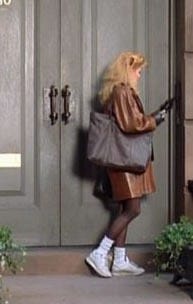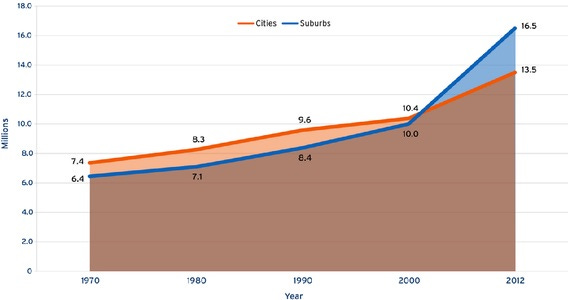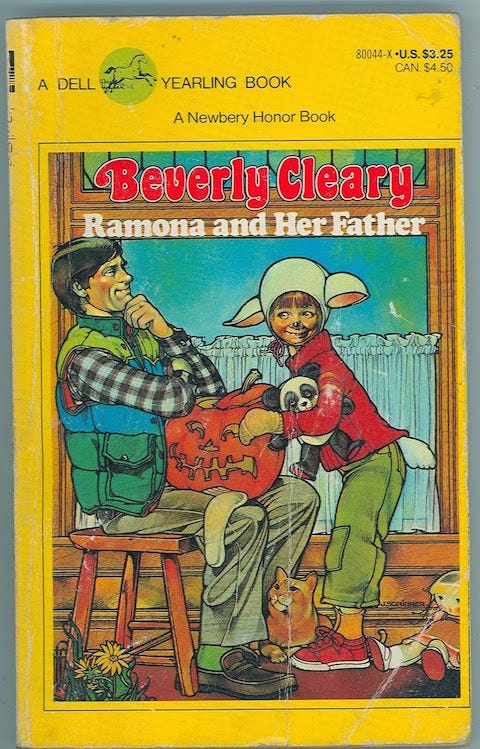So What, Who Cares (vol 2, issue 49) Why we're all sitting in sprawl

Hello! It was a delight to hear about your commutes: Some of you have the enviable option of walking to work, others of you go through centuries-old towns every day, many of you listen to podcasts or audiobooks. Thanks for sharing! I love knowing how you roll.
Today's question to you all, inspired by the moment in pop culture below: What book from your childhood blew your mind open and helped form your sense of self? Share your world-shaking reads via email or Twitter.
*
On a commute-related note, did you know that sprawl is costing the U.S. over $1 trillion annually, according to a report by LSE Cities and the Victoria Transport Policy Institute? How do you get that number? Says them:
It can increase per capita land consumption up to 80 percent and car use by up to 60 percent. Together these outcomes create social costs that amount to $626 billion a year for people living in sprawling areas and $400 billion for those outside of them, the report estimates.
And what is causing the sprawl? Jobs. According to the Brookings Institute, this is a trend a few decades in the making: the "neighborhood density of jobs" (i.e. how many jobs are in a given radius) stayed steady in urban areas, while suburban job density spread out. Because people go where the jobs are, they spread out too.
And if you're middle class, you're spending an awful lot of money on transit costs. Recent Bureau of Labor data shows that "the middle-class pays an outsized share on gas, vehicle maintenance, car insurance."

So what? Jobs aren't the only thing that's spread out to the 'burbs. Poverty did too. And suburban-style poverty is tough -- the 'burbs do not have the dense community ties that let poor people pool childcare, knowledge on navigating social services or other reciprocal social interactions. Because the suburbs have a built-in car dependency, the need for reliable transportation is an aggravating factor in a way it wouldn't be in an urban setting. And because suburban poverty grew relatively rapidly, many suburban communities don't have the social services safety net or the community know-how to handle poverty-related issues or help their poorest residents climb out of a no-win situation.
And in case you doubted that real wealth in this country comes from having control over your time, consider this: the wealthiest deciles in the U.S.spend less on transit, proportionally speaking, because they can afford to live closer to work. The rich are spending less money and less time getting to work.
Their poor neighbors, on the other hand, spend an awful lot of time on public transit (vol 2, issue 42).
Who cares? Policy nerds, who are trying to figure out how to bridge the disconnect between where the job growth is versus where the infrastructure is. And commuters, who are negotiating ever-widening radii of traffic every day.
So who is this good news for? Anyone who's not legally prohibited from buying stock in Amazon.com. They own Audible.com, and the market for audiobooks is booming.
*

Today's moment in pop culture: Beverly Cleary turned 99 on Sunday, and in her honor, FlavorWire put together a collection of 25 awesome vintage Cleary covers. The Dell Yearling covers of the Ramona books are the ones I remember seeing in the library -- they're very of-the-1980s, no?
When I looked at the Ramona and Her Father cover, I was immediately reminded of Stephanie V.W. Lucianovic's (@grubreport) piece for Avidly, "Ramona at Forty," where she wrote:
Running throughout the entire Ramona and Beezus oeuvre, and illustrated by Mr. Quimby’s ill-fated career, is the recognizably adult theme that quite often, parents set aside pre-kid dreams for post-kid necessities because making their kids’ dreams come true is the new dream.
And when I got to the cover for Sister of the Bride, I recalled Lizzie Skurnik's (@lizzieskurnik) 2008 Jezebel piece, "Veiled Messages," where she wrote:
It's interesting, on the cusp of the feminist movement with its cowl-neck-sporting support groups, Cleary chose to offer a defense of the women's supIport groups that already did exist.
I was not a fan of Ramona -- I am one of nature's Order Muppets and Ramona was a little too close to a Chaos Muppet for my comfort -- but I remember reading Sister of the Bride in late elementary school and being blown away by the idea that there were multiple ways to be a woman in the world. It was a revolutionary idea for a 5th grader.
And, going by this week's Ask Polly -- "Should I have a baby or establish my career first?" -- we (as a culture) are still discovering that there's more than one way to be a woman or a man in the world.
*
Are there typos? I apologize in advance. The only editing class I did not get an A in was copyediting.
Did you miss an issue of So What, Who Cares? The archive is here.
Would you like a run-down of all the books and other pop culture picks ever mentioned in this newsletter? Then check out the Pinterest board. (Note: None of the links are affiliate links; I do not make money off anything I link to.)
If you really like So What, Who Cares?, tell a friend to subscribe.

